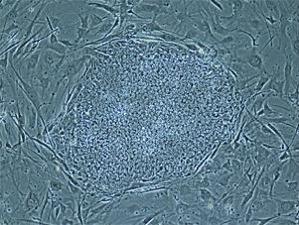May 16, 2013
LONDON: In a major medical breakthrough, scientists have for the first time converted human skin cells into embryonic stem cells, capable of transforming into any other cell type in the human body.

May 16, 2013
LONDON: In a major medical breakthrough, scientists have for the first time converted human skin cells into embryonic stem cells, capable of transforming into any other cell type in the human body.

This image made available by the Oregon Health and Science University shows a stem cell colony developed from cloned human embryos. (AP Photo)
The cloned embryos which produced the stem cells can make new heart muscle after they are damaged from a heart attack besides new bones, brain tissue or any other type of cell in the body.
Scientists used the same cloning technique that had created Dolly the sheep, to turn human skin into embryonic stem cells overcoming technical problems that had frustrated scientists for more than a decade on how to create batches of the body's super cells from donated skin.
Another noteworthy aspect of this research is that it does not involve the use of fertilized embryos, a topic that has been the source of a significant ethical debate.
The technique used by Dr Shoukhrat Mitalipov and Dr Paula Amato from Oregon National Primate Research Center (ONPRC) is a variation of a commonly used method called somatic cell nuclear transfer, or SCNT.
It involves transplanting the nucleus of one cell, containing an individual's DNA, into an egg cell that has had its genetic material removed.
The unfertilized egg cell then develops and eventually produces stem cells.
Dr Amato said, "we first carried out the study on monkeys for several years. The work with humans was being done over the last five years. This is the first time embryonic human stem cells have been derived using the technique called SCNT. This is the first time this has been successfully achieved in humans. The process is relatively efficient requiring a relatively small number of human eggs to produce each cell line making it practical and feasible."
She said, "These stem cells can be differentiated into any cell type in the body and are genetically identical to the somatic cell donor. They can be used to study diseases and ultimately as cell-based therapies to treat those diseases while avoiding the issue of immune rejection."
Dr Amato added, "This breakthrough will greatly help diseases like heart disease, neurodegenerative diseases like Parkinson's, Alzheimer's, diabetes and spinal cord injury. However it will be several years before it is used as a therapy. The next step now is to make disease-specific stem cell lines – embryonic stem cell lines from patient's with a particular disease, and to use those cell lines to then learn more about the mechanism of the disease by studying the cells in vitro."
One important distinction is that while the method might be considered a technique for cloning stem cells, commonly called therapeutic cloning, the same method would not likely be successful in producing human clones otherwise known as reproductive cloning.
Dr Mitalipov says the breakthrough marks the first time human stem cells have been produced via nuclear transfer and follows several unsuccessful attempts by research groups worldwide.
"It is believed that stem cell therapies hold the promise of replacing cells damaged through injury or illness," Dr Mitalipov added.
The research breakthrough, follows previous success in transforming monkey skin cells into embryonic stem cells in 2007.
This latest research was published in the journal Cell May 15.
"A thorough examination of the stem cells derived through this technique demonstrated their ability to convert just like normal embryonic stem cells, into several different cell types, including nerve cells, liver cells and heart cells. Furthermore, because these reprogrammed cells can be generated with nuclear genetic material from a patient, there is no concern of transplant rejection," explained Dr Mitalipov. "While there is much work to be done in developing safe and effective stem cell treatments, we believe this is a significant step forward in developing the cells that could be used in regenerative medicine."
The Mitalipov team's success in reprogramming human skin cells came through a series of studies in both human and monkey cells. Previous unsuccessful attempts by several labs showed that human egg cells appear to be more fragile than eggs from other species. Therefore, known reprogramming methods stalled before stem cells were produced.
To solve this problem, the OHSU group studied various alternative approaches first developed in monkey cells and then applied to human cells.
Through moving findings between monkey cells and human cells, the researchers were able to develop a successful method.
The key to this success was finding a way to prompt egg cells to stay in a state called "metaphase" during the nuclear transfer process.
Metaphase is a stage in the cell's natural division process when genetic material aligns in the middle of the cell before the cell divides.
The research team found that chemically maintaining metaphase throughout the transfer process prevented the process from stalling and allowed the cells to develop and produce stem cells.
Several years of monkey studies that utilize somatic cell nuclear transfer have never successfully produced monkey clones.
It is expected that this is also the case with humans.
"Our research is directed toward generating stem cells for use in future treatments to combat disease," added Dr Mitalipov. "While nuclear transfer breakthroughs often lead to a public discussion about the ethics of human cloning, this is not our focus, nor do we believe our findings might be used by others to advance the possibility of human reproductive cloning."
Courtesy: TOI












































































































